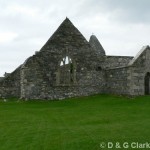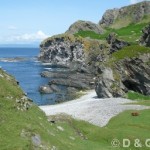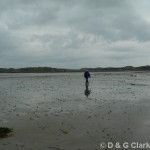Colonsay is a small island lying to the north of Islay and West of Jura. It is an enchanting island of neat cottages and crofts, imposing cliffs and stunning white sandy bays. The island is eight miles long and half that at its widest point. There is one winding road encircling the island with lots of tracks to discover the delights of Colonsay. The highest point Carnan Eoin is 143 metres above sea level and offers stunning views over the dramatic scenery. Open moorland gives way to dramatic cliffs which lead down to glorious sandy beaches.
At the southern end of the island is the Strand, a mile wide stretch of sand, which joins Colonsay to another small island, Oransay, which can be reached at low tides. On Oransay are the ruins of a 14th century Augustinian Priory which houses one of the finest collections of carved Celtic tombstones in Argyll. The whole of the Island is a RSPB Reserve.
For its size, Colonsay and Oransay provide an enormous variety of natural habitats. They include both ancient and cultivated woodland, moorland and peat bogs, cultivated farmland, meadows and rough pastures, the machair or raised beaches and tidal flats. The shoreline is also very varied with many sandy beaches as well as rocky shoreline and high cliffs. There are also numerous offshore reefs and islands.
Birdwatchers have over 150 birds to spot from the British list. Both Red-billed Choughs and Corn Crake breeds on Colonsay and Oransay. For botanists there are 500 species of local flora recorded. The machair bursts into flower in May and is at its best in July.
- Ordnance Survey Landranger Series Maps ( 1:50,000 ) number 61
- Ordnance Survey Explorer Series Maps ( 1:25,000 ) number 354

Where to watch birds
Balnahard and Dunan na Nighean (NR4097 to NR4399 plus NM4100 and NM4200 – Explorer Sheet 354, Landranger Sheet 61)
Habitat: Rocky crags, cliffs, machair meadows, sandy dunes and beaches.
Birds of interest: Jackdaw, Red-billed Chough, Corn Crake, White and Pied Wagtail, Willow Warbler, Northern Wheatear, Ringed Plover, Lapwing, Golden Plover, Common Shelduck, Meadow Pipit, Linnet, Twite, Common Stonechat, Common Buzzard, Golden Eagle, Kestrel, Peregrine Falcon, Sparrowhawk, Arctic Tern, Shag, Kittiwake, Common and Black Guillemot, Razorbill, Manx Shearwater, Gannet.
Colonsay Ferry
Habitat: Sea crossing from Oban or Kennacraig to Colonsay.
Birds of interest: Red-throated Diver, Black-throated Diver, Great Northern Diver, Fulmar, Sooty Shearwater, Manx Shearwater, Balearic Shearwater, European Storm Petrel, Leach’s Storm-Petrel, Gannet, Arctic Skua, Great Skua, Kittiwake, Common Guillemot, Razorbill, Black Guillemot, Little Auk, Puffin.
Colonsay House (NR3996 – Explorer Sheet 354, Landranger Sheet 61)
Habitat: Meadows, marshes and woodlands.
Birds of interest: Linnet, Twite, Meadow Pipit, Sedge Warbler, Common Stonechat, Song Thrush, Sky Lark, Lesser Redpoll, Long-tailed Tit, Chiffchaff, Blackcap, Common Snipe, Common Buzzard, Mallard.
Loch Fada (East, Middle and West) (NR3995, NR3895 and NR3795 – Explorer Sheet 354, Landranger Sheet 61)
Habitat: Small Lochs surrounded by reedbeds, marshy meadows and rocky crag on one site.
Birds of interest: Linnet, Twite, Meadow Pipit, Sedge Warbler, Common Stonechat, Song Thrush, Sky Lark, Common Snipe, Common Buzzard, Mallard, Little Grebe, Slavonian Grebe, Water Rail, Grey Heron, Canada Geese, Greylag Geese, Raven.
Kilchattan (Upper and Lower), Port Mohr and Machrins Golfcourse (NR3695, NR 3694, NR3594, NR3693 and NR3593 – Explorer Sheet 354, Landranger Sheet 61)
Habitat: Machair meadows, rocky crags and bays and dunes.
Birds of interest: Linnet, Twite, Sedge Warbler, Whitethroat, Common Stonechat, Song Thrush, Starling, Sky Lark, White and Pied Wagtail, Northern Wheatear, Corn Crake, Common Eider, Common Shelduck, Mallard, Golden Plover, Ringed Plover, Turnstone, Snipe, Curlew, Dunlin, Sandpiper, Oystercatcher, Common Raven, Common Buzzard, Hen Harrier, Red-billed Chough, Arctic Terns, Gannets, Manx Shearwater, Kittiwake, Grey Heron, Gulls.
Kiloran Bay (NR3997 to NR4098 – Explorer Sheet 354, Landranger Sheet 61)
Habitat: Sandy bay at the N end of Colonsay.
Birds of interest: Fulmar, Shag, Razorbill, Common and Black Guillemot, Ringed Plover, Turnstone, Kittiwake, Eider, Rock Dove, Red-billed Chough.
Oronsay (NR3489 – Explorer Sheet 354, Landranger Sheet 61)
Habitat: Island accessible at low tide from Colonsay. RSPB reserve.
Birds of interest: Whooper Swan, Greenland White-fronted Goose, Greylag Goose, Greater Canada Goose, Barnacle Goose, Brent Goose, Common Shelduck, Eurasian Wigeon, Eurasian Teal, Mallard, Common Eider, Red-breasted Merganser, Red-throated Diver, Great Northern Diver, Great Cormorant, Shag, Grey Heron, Hen Harrier, Eurasian Sparrowhawk, Common Buzzard, Golden Eagle, Common Kestrel, Merlin, Peregrine Falcon, Corn Crake, Oystercatcher, Ringed Plover, European Golden Plover, Northern Lapwing, Dunlin, Black-tailed Godwit, Whimbrel, Common Redshank, Greenshank, Rock Dove, Sky Lark, White Wagtail, Common Stonechat, Northern Wheatear, Sedge Warbler, Red-billed Chough, Common Raven, Linnet, Twite, Lapland Bunting, Snow Bunting.
Port Ban (Pigs’ Paradise) (NR3797 – Explorer Sheet 354, Landranger Sheet 61)
Habitat: Steep Sea Cliffs and raised beach.
Birds of interest: Twite, Meadow Pipit, Linnet, Common Stonechat, Red-billed Chough, Kittiwake, Common and Black Guillemot, Razorbill, Shag, Peregrine Falcon, gulls.
(The) Strand and Garvard (NR3690 – Explorer Sheet 354, Landranger Sheet 61)
Habitat: Area of sand, mud and saltings between Colonsay and Oronsay exposed at low tide and at both sides surrounded by rocky outcrops.
Birds of interest: Twite, Lesser Redpoll, Meadow Pipit, Linnet, Stonechat, Red-billed Chough, Greater Canada Geese, Common Eider, Common Buzzard, Hen Harrier, Golden Eagle, Oystercatcher, Ringed Plover, Dunlin, Whimbrel, Eurasian Curlew, Bar-tailed Godwit, Greenshank, Common Sandpiper, gulls.




